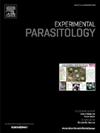In silico screening and molecular dynamic simulations of FDA-approved drugs as an inhibitor of trypanothione reductase of Leishmania donovani
IF 1.6
4区 医学
Q3 PARASITOLOGY
引用次数: 0
Abstract
Visceral leishmaniasis (VL) is mainly caused by Leishmania donovani (Ld) and Leishmania (L.) infantum, and it is prevalent in Brazil, India and East Africa. VL is a serious health issue, affecting millions of people worldwide and causing thousands of deaths annually. The current treatments for leishmaniasis are inadequate because of their low efficacy, toxicity and growing resistance, underscoring the pressing need to explore new drugs.
Among the various molecular targets explored, trypanothione reductase (TR) is of special relevance because of its crucial function in regulating the parasite's redox homeostasis. Inhibiting TR can disrupt the redox homeostasis of the parasites, offering a promising strategy for developing new drugs with improved efficacy and safety profiles. In this study, 3D structure model of TR was elucidated by homology modelling and potential novel inhibitors against Leishmania donovani TR (LdTR) were identified by performing high-throughput virtual screening of 1615 FDA-approved drugs from the ZINC database via molecular docking, selecting top ligands on the basis of their high binding score and number of hydrogen bonds. These best hits are further subjected to Molecular Dynamics (MD) simulation and Molecular Mechanics Poisson- Boltzmann Surface Area (MM-PBSA) analysis. The results indicated that the binding scores of Dasatinib, Regorafenib, Bicalutamide, Raloxifene and Silodosin are −10.9 and −10.6, −10.1, −9.7 and −9.6 kcal/mol respectively. The lead compounds i.e. Dasatinib, Regorafenib, Bicalutamide, Raloxifene and Silodosin complexes with our target TR were found to be stable during MD simulation studies. Furthermore, MM-PBSA analysis demonstrated that these compounds had a high negative binding free energy. Thus, in-silico results showed that Dasatinib, Regorafenib, Bicalutamide and Raloxifene and Silodosin seem to have efficacy against TR for the treatment of VL. With further in vitro and in vivo investigations Dasatinib, Regorafenib, Bicalutamide, Raloxifene and Silodosin could be a good candidate of choice for combating leishmaniasis.

fda批准的多诺瓦利什曼原虫锥虫硫酮还原酶抑制剂的筛选和分子动力学模拟。
内脏利什曼病(VL)主要由多诺瓦利什曼原虫(Ld)和婴儿利什曼原虫(L.)引起,流行于巴西、印度和东非。VL是一个严重的健康问题,每年影响全世界数百万人,造成数千人死亡。目前治疗利什曼病的方法不足,因为它们的疗效低、毒性大且耐药性日益增强,这突出表明迫切需要开发新药。在探索的各种分子靶点中,锥虫硫酮还原酶(TR)因其在调节寄生虫氧化还原稳态中的关键功能而具有特殊的相关性。抑制TR可以破坏寄生虫的氧化还原稳态,为开发具有更高疗效和安全性的新药提供了一个有希望的策略。本研究通过同源性建模确定了TR的三维结构模型,并通过分子对接对锌数据库中1615种fda批准的药物进行高通量虚拟筛选,根据其高结合评分和氢键数量选择顶部配体,确定了潜在的新型抗多诺瓦利什曼原虫TR (LdTR)抑制剂。这些最佳命中进一步进行分子动力学(MD)模拟和分子力学泊松-玻尔兹曼表面积(MM-PBSA)分析。结果表明,达沙替尼、瑞非尼、比卡鲁胺、雷洛昔芬和西洛多辛的结合分数分别为-10.9和-10.6、-10.1、-9.7和-9.6 kcal/mol。在MD模拟研究中发现,与我们的目标TR的先导化合物,即达沙替尼、瑞戈非尼、比卡鲁胺、雷洛昔芬和西洛多辛复合物是稳定的。此外,MM-PBSA分析表明,这些化合物具有较高的负结合自由能。因此,计算机实验结果表明,达沙替尼、瑞戈非尼、比卡鲁胺、雷洛昔芬和西洛多辛治疗VL似乎对TR有疗效。随着进一步的体外和体内研究,达沙替尼、瑞非尼、比卡鲁胺、雷洛昔芬和西洛多新可能成为对抗利什曼病的良好候选药物。
本文章由计算机程序翻译,如有差异,请以英文原文为准。
求助全文
约1分钟内获得全文
求助全文
来源期刊

Experimental parasitology
医学-寄生虫学
CiteScore
3.10
自引率
4.80%
发文量
160
审稿时长
3 months
期刊介绍:
Experimental Parasitology emphasizes modern approaches to parasitology, including molecular biology and immunology. The journal features original research papers on the physiological, metabolic, immunologic, biochemical, nutritional, and chemotherapeutic aspects of parasites and host-parasite relationships.
 求助内容:
求助内容: 应助结果提醒方式:
应助结果提醒方式:


